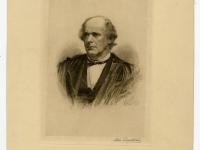Answer: "In God We Trust"
The 1864 two-cent coin was the first piece of existing American currency to be modified to include the motto. Almost one hundred years passed before the motto was placed on paper currency, which was first introduced under Chase’s tenure as secretary of the treasury in 1864. Consulting with the director of the Philadelphia Mint, Chase worked to come up with a slogan. After some trial and error, Chase, and eventually Congress approved the phrase "In God We Trust," but its overall use of American currency was not enforced, so it only appeared sporadically.
In 1956, Congress and the president approved a joint resolution making “In God We Trust” the national motto, and the first paper bill printed with the phrase was the 1957 one-dollar silver certificate.
HSP has a sizeable collection of Salmon P. Chase’s papers (#121), which spans from the 1820s to the 1880s, and covers Chase’s work an Ohio governor and senator, as secretary of the treasury, and as the chief justice of the United States. Chase’s papers provide insights into such topics as the financial and political affairs of the Civil War and the issue of the expansion of slavery into new territories in the 1850s. Among the materials are Chase’s diaries, journals, incoming and outgoing correspondence, speeches, and legal opinions.

